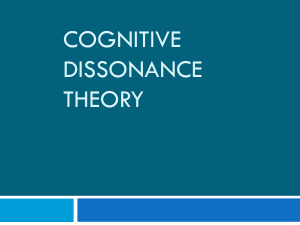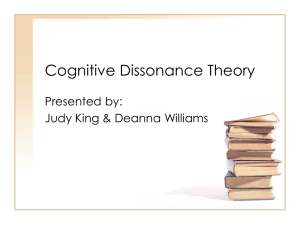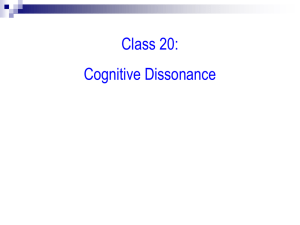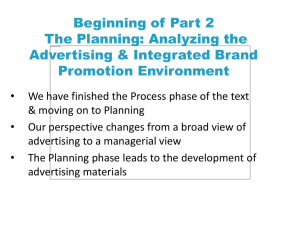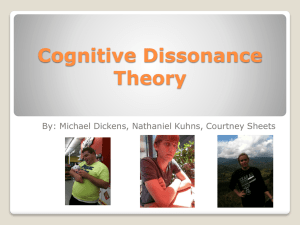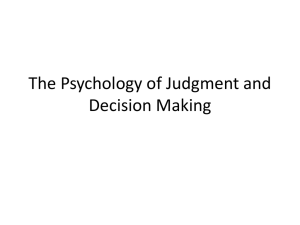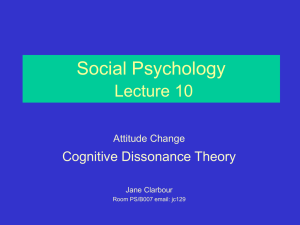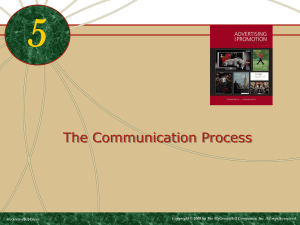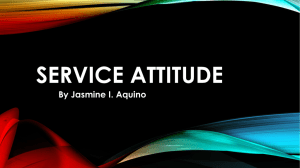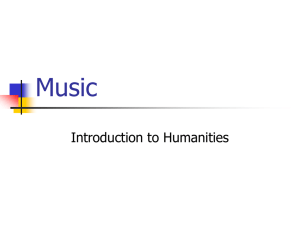Persuasion Relationships ~ MR
advertisement
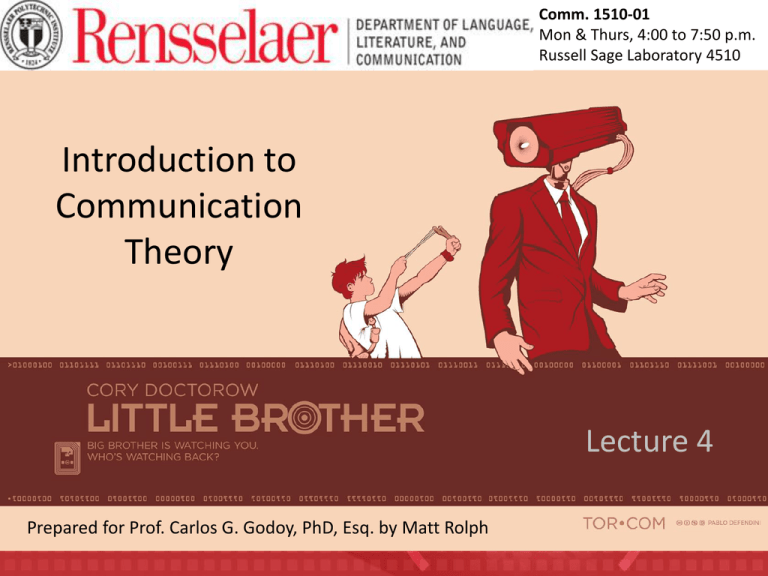
Comm. 1510-01 Mon & Thurs, 4:00 to 7:50 p.m. Russell Sage Laboratory 4510 Introduction to Communication Theory Lecture 4 Prepared for Prof. Carlos G. Godoy, PhD, Esq. by Matt Rolph People • Do you have a best friend? – Is it easier to communicate with that person? • How about someone who irritates you? – Is it tougher to communicate with that person? • Can it be easier or more difficult to communicate with family? More difficult with a boss? “Step Brothers” (2008) Relationships • Communication happens in relationships of many kinds, like those at work, in class, or in a family. • Cause-and-effect models of communication can’t easily explain the complexity of relationships and the way they affect communication. Not • A cause and effect chain: a -> b -> c -> d • Instead, a relationship x = b2 + 2a ---a – 5d In other words, complicated. Interactional View Chapter 13 • Individual behavior is better understood as part of a system. • Family system: – A self-regulating, interdependent network of feedback loops guided by member’s rules; the behavior of each person affects and is affected by the behavior of another. (Griffin p. 170) Paul Watzlawick 1921-2007 Interactional View Family Homeostasis • The tacit collusion of family members to maintain the status quo; in other words, the way a group collaborates, sometimes unconsciously, to keep things stable – even if they don’t consciously want to. • One explanation involves a ‘symptom strategy’ – explaining the silence using semi-reasonable excuses, i.e. I am too tired for that today. Axioms of Interpersonal Communication • One cannot NOT communicate. • Communication = Content + Relationship • The nature of a relationship depends on how both parties punctuate the communication sequence • Communication is either symmetrical or complementary • Communication always includes more than the meaning of the words or message Symmetrical v. Complementary • Symmetrical interchange is based on equal power, whereas complementary communication is based on differences of power. • Healthy relationships include both kinds of communication. The Interactional View • Axiomatic description (with corollaries ) of communication as a system. • Emphasizes issues of control, status, and power. • Relationships are assessed through an exchange of at least two messages Rogers and Farace • Coding system categorizes control in ongoing marital interaction. • Bids for dominance do not necessarily result in control of the interaction One Up • Seeks to control One Down • Yields control • Neutralizes One Across control The Franklin Family • A “disturbed family system” • The Franklin family (p. 169 in Griffin) – Sonia – the concert pianist (and mom) – Stan – the man at work (and dad) – Laurie – honors student (responsible sister) – Mike – the problem child Olympic athlete Michael Phelps -probably not the image he hopes you’ll remember The Simpsons • Early episodes in particular feature family themes • “Bart the Genius” (Season 1: Episode 2) • Clips: • http://www.hulu.com/watch/29524/the-simpsonsscrabble#x-4,vclip,94 • http://www.hulu.com/watch/29527/the-simpsons-aptitudetest-cheater#x-4,vclip,94 • http://www.youtube.com/watch?v=r6qPVWhPUX0 Trapped with no place to go … – Family systems are highly resistant to change. – Double binds are contradictory demands on members of the system. – The paradox of the double bind is that the highstatus party in a complementary relationship insists that the low-status person act as if the relationship were symmetrical. Changing the game … • … by changing the rules: – Destructive rules can be changed only when members analyze them from outside the system. – Reframing is the process of altering perspective and looking at things in a new light. – Accepting a new frame means rejecting the old one. – Adapting a new interpretive frame usually requires outside help. A Critique •Proposed adjustments to the Interactional View •Not all nonverbal behavior is communication – in the absence of relationship and intentionally shared code, nonverbal behavior is informative rather than communicative Janet Beavin Bavelas A Critique •Proposed adjustments to the Interactional View •A “whole message model” integrates verbal and nonverbal communication. •The term metacommunication should be reserved for communication about communication Janet Beavin Bavelas Limits of System Theories • Apply well to multivariate systems, but … – Systems theories involving people are difficult to evaluate because of equifinality—a given behavioral outcome could be caused by various interconnected factors. – Equifinality: In the study of systems, the recognition that different initial states can lead to similar end states; the property of allowing or having the same effect or result from different events Influence • Influence research focuses on communication strategies that elicit behavioral compliance. Attitudes • Attitudes are internal responses made us of the ways people think, feel, and intend to act. – Cognitive: What do you believe? – Affective: What does your heart say? – Behavioral: What do you plan to do? 1 2 3 Strongly Disagree Slightly Disagree Disagree 4 5 6 7 No Opinion Slightly Agree Agree Strongly Agree Example of a 7-point Likert semantic differential scale Social Judgment Theory: Ch. 14 • Three Latitudes –Acceptance –Rejection –Noncommitment Muzafer Sherif 1906-1988 Example Acceptance The location and width of each interrelated latitude may vary a great deal from person to person Noncommitment Rejection Ego Involvement • Refers to the importance of an issue to an individual. • The favored position anchors all other thoughts on a topic. • Features of high-ego involvement: – Noncommitment nearly nonexistent – Rejection latitude is wide. – People who hold extreme views care deeply. Judging the Message: Contrast and Assimilation Errors • Sherif theorized that we use our own anchored attitude as a comparison point when we hear a discrepant message. • People “cold” to an idea who hear a message on that topic perceive contrast – even a slight disagreement seems large and the message is rejected. • Contrast: A perceptual error whereby people judge messages that fall within their latitudes of rejection as further from their anchor than they really are. Judging the Message: Contrast and Assimilation Errors • Sherif theorized that we use our own anchored attitude as a comparison point when we hear a discrepant message. • People “hot” for an idea who hear a message on that topic that is aligned with their view accept it even when there are good reasons not to do so. • Assimilation: A perceptual error whereby people judge messages that fall within their latitudes of acceptances as less discrepant from their anchor than they really are. Attitude Change • According to social judgment theory, we judge each received message, comparing it to our anchored position – this is the first stage in attitude change. • In the second stage, we shift our anchor in response to the message. • Sherif thought that both stages take place below the threshold of consciousness. Discrepancy and Attitude Change • How much our attitude changes – how much our anchor shifts – depends on the level or discrepancy between the message and our initial anchor point. • The greater the discrepancy, the more people adjust their attitudes. • According to Sherif, volition (will) is not a factor for the hearers. Boomerang Effect • Attitude change in the opposite direction of what the message advocated; listeners driven away from rather than drawn to an idea. Sherif’s Advice for Persuaders • For maximum influence, select a message right on the edge of the audience's latitude of acceptance. • Persuasion is a gradual process consisting of small movements. • The most dramatic, widespread, and enduring attitude changes involve changes in reference groups with differing values. Evidence supporting this theory • Evidence that argues for acceptance. – Research on the predictions of social judgment theory requires highly ego-involved issues. – Studies have demonstrated three significant findings. • Messages from highly credible speakers will stretch the latitude of acceptance. • Ambiguity effectively places statements within the latitude of acceptance. • Dogmatic people have chronically wide latitudes of rejection. Critique • How wide is your theoretical latitude of acceptance? – Application of the theory raises ethical problems. – The theory has practical utility for persuaders. – Like all cognitive explanations, social judgment theory assumes a mental structure and process that are beyond sensory observation. – While it has not been widely tested empirically, research does support it, validating its claims while proving the theory falsifiable. – Despite these reservations, social judgment theory is an elegant, intuitively appealing approach to persuasion. Social Neurologist John Cacioppo Ch. 15 Richard Petty & John Cacioppo Central Route Peripheral Route Mental Effort: High Mental Effort: Low High message elaboration No message elaboration Message Elaboration • The extent to which a person carefully thinks about issue-relevant arguments contained in a persuasive communication. • ELM has been a leading communication theory, perhaps the leading theory, for the past 20 years Central Route • The path of cognitive processing that involves scrutiny of message content – Mental work, thinking about the message • Petty and Cacioppo assume that people are motivated to hold ‘correct’ attitudes but are not always logical in their approaches to meeting this goal. • There is only so much time and energy, and there are many, many messages – a large-mesh mental ‘spam filter’ (heuristic processing) is necessary. – Message elaboration Peripheral Route • A mental shortcut process that accepts or rejects a message based on irrelevant cues as opposed to actively thinking about the issue. – Robert Cialdini’s six cues that trigger a programmed response: • • • • • • Reciprocation – “You owe me” Consistency – “We’ve always done it that way” Social Proof – “Everybody’s doing it” Liking – “Love me, love my ideas” Authority – “Just because I say so” Scarcity – “Quick, before they’re all gone” Motivation for Elaboration • Motivation plays a role in cognition and message elaboration • Some individuals have a high need for cognition, will ‘think about it’ even if ‘it’ is not personally relevant • 4 Question Need-for-Cognition Scale – I really enjoy a task that involves coming up with new solutions to problems. (Yes = high need) – I prefer my life to be filled with puzzles that I must solve. (Yes) – I like tasks that require little thought once I have learned them. (No) – Thinking is not my idea of fun. (No) Ability to Elaborate • Issue-relevant thinking (elaboration) requires more than intelligence; it requires concentration. • Distraction disrupts elaboration. • Repetition may increase the possibility of elaboration. Biased v. Objective Elaborations • ‘Thinking about it’ does not guarantee objectivity. • Biased elaboration: Top-down thinking in which predetermined conclusions color the supporting data. • Objective elaboration: Bottom-up thinking in which facts are scrutinized without bias; seeking truth wherever it might lead. Strong, Weak, and Neutral • Arguments may be strong, weak, or neutral – influencing the way they are processed via the central route. • ELM presumes argument strength is an important variable. • Strong arguments generate favorable thoughts when examined, and may increase the message’s likelihood to persist over time, resist counterpersuasion, and predict future behavior • Weak arguments look even worse on closer examination, offend sensibilities. Peripheral Cues • Petty and Cacioppo include the kinds of social transactions based on the influence of the speaker or source, likability, credibility, as when an idolized, attractive, or famous person speaks a message • These, however, can fail to achieve the desired persistence over time, resistance to counterpersuasion, and to predict future behavior – the audience pays more attention to the speaker or source than to the message Nilsen’s Significant Choice • ELM describes effective persuasion techniques, can, in theory, be used to design messages that bypass rational faculties • Thomas Nilsen is concerned with what is ethical communication and persuasion • Advocates message design that fosters free, informed, rational, and critical choice – significant choice Leon Festinger COGNITIVE DISSONANCE 1919-1989 Aesop’s fable of the Fox and the Grapes Unable to leap high enough to reach the grapes, the fox concludes that they are sour and best left uneaten. “Graveyard smoker” by Florida artist Chris Boone Smokers experience cognitive dissonance, particularly when they know a lot about the consequences Cognitive Dissonance • The distressing mental state caused by inconsistencies between a person’s two beliefs or a belief and an action • What are some other examples? Reducing Dissonance • Festinger hypothesized that there are three mental mechanisms people use to reduce dissonance: – selective exposure – postdecision dissonance – minimal justification Selective Exposure • The tendency people have to avoid information that would create cognitive dissonance because it’s incompatible with their current beliefs Postdecision Dissonance • Strong doubts experienced after making an important, close-call decision that is difficult to reverse Minimal Justification • A claim that the best way to stimulate an attitude change in others is to offer just enough incentive to elicit counterattitudinal behavior • Counterattitudinal advocacy: publicly urging others to believe or do something that is opposed to what the advocate actually believes Compliance • In this case, “compliance” is ‘public conformity to another’s expectation without necessarily having a private conviction that matches the behavior’ A Classic Experiment • “Would I lie for a dollar?” The $1/$20 study • Festinger and James Carlsmith recruited Stanford University men in a study allegedly investigating industrial relations, a series of menial tasks designed to be boring and repetitive • At the end of the hour, the experimenter approached the subject claiming an assistant had failed to arrive and offering him a sum to convince a young woman in a waiting room to participate in the same study • Some were offered $20, some $1 A Classic Experiment • Some refused, but most students tried to recruit the young woman • Those who accepted $20 later confessed that they believed the task was dull • Those who accepted $1 maintained it was much more enjoyable – I’m a Stanford man. Am I the kind of guy who would lie for a dollar? No way. Actually, what I told the girl was true. The experiment was a lot of fun. The Cause and Effect of Dissonance THREE STATE-OF-THE-ART REVISIONS The Rationalizing Animal • Elliot Aronsen proposes revising the Cognitive Dissonance to eliminate “conceptual fuzziness” by more specifically stating the conditions under which a person would experience dissonance A B C D Attitude/Behavior Inconsistency Dissonance Created Attitude Change Dissonance Reduced In Festinger’s Process Model of Cognitive Dissonance, the A->B link is unclear The Rationalizing Animal • Aronsen traces the problem not to logical inconsistency, as Festinger theorized, but to our psychological inconsistency • We need to maintain self-esteem • “If dissonance exists, it is because the individual’s behavior is inconsistent with his self-concept” • According to Aronsen, the amount of dissonance a person can experience is directly proportional to the effort he or she has invested in the behavior Personal Responsibility for Bad Outcomes • AKA “the New Look” • Joel Cooper argues that it’s the knowledge that one’s actions have unnecessarily hurt another person that generates dissonance. • Cooper concludes that dissonance is a state of arousal caused by behaving in such a way as to feel personally responsible for bringing about an aversive event. Self-Affirmation to Dissipate Dissonance • Claude Steele focuses on dissonance reduction. • He believes that high self-esteem is a resource for dissonance reduction. • Steele asserts that most people are motivated to maintain a self-image of moral and adaptive adequacy. Persuasion through Dissonance Theory into practice • Don’t promise lavish benefits • Work to develop a friendly relationship with the subject – to avoid triggering selective exposure screening, and to be there after compliance when postdecision dissonance arises • Offer just enough encouragement (minimal justification) • Avoid making an offer the subject cannot refuse – as long as counterattitudinal actions are freely chosen and publicly taken, people adopt beliefs to support what they’ve done • Induce compliance by getting the subject to grasp the potential downside of that behavior for others (personal responsibility for negative outcomes) Critique • Cognitive dissonance may not be falsifiable. – Festinger never specified a reliable way to detect the degree of dissonance a person experiences (a dissonance thermometer). • Patricia Devine applauds researchers who have attempted to gauge the arousal component of dissonance. – Daryl Bem believes that self-perception is a much simpler explanation of attitude change than cognitive dissonance is. • His version of the $1/$20 experiment supports his contention. • Bem suggests that cognitive dissonance does not follow the rule of parsimony. – Despite detractors, cognitive dissonance theory has energized objective scholars of communication for 50 years. Cialdini Milgram, 1963 • The experimenter (E) orders the teacher (T), the subject of the experiment, to give what the latter believes are painful electric shocks to a learner (L), who is actually an actor and confederate. The subject believes that for each wrong answer, the learner was receiving actual electric shocks, though in reality there were no such punishments. Being separated from the subject, the confederate set up a tape recorder integrated with the electro-shock generator, which played pre-recorded sounds for each shock level Milgram • Most of the participants (teacher) gave the full shocks to the subjects – shocks that would have been lethal if real • Deep-seated sense of authority extorts compliance Authority • • Height: We overestimate height based on authority • Suit: Uniform- the bum vs. the suit • Titles: lawyer, professor, doctor • Prestige autos: Who do we honk at most? Bandura

